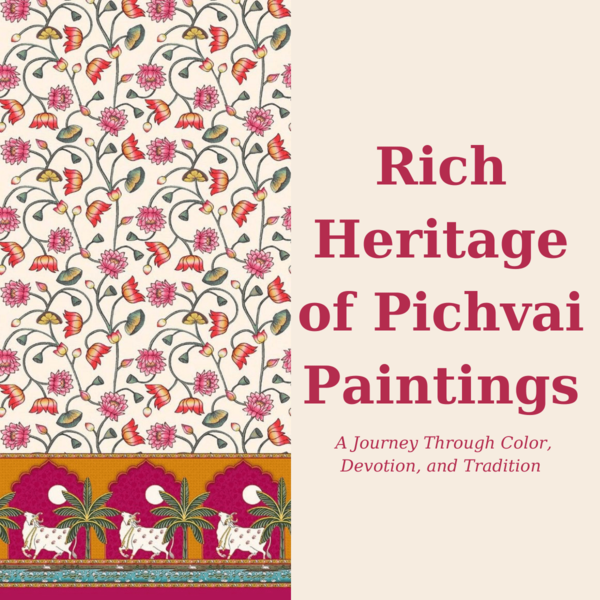Rich Heritage of Pichvai Paintings
A Journey Through Color, Devotion, and Tradition of India, Rajasthan


Pichvai paintings, originating from the town of Nathdwara in Rajasthan, India, are not just artworks; they are embodiments of devotion, culture, and tradition. These intricate and vibrant paintings have been an integral part of Indian art and religious practices for centuries, offering a glimpse into the rich tapestry of Hindu mythology and spiritual beliefs. In this blog post, we delve into the fascinating world of Pichvai paintings, exploring their history, significance, techniques, and enduring legacy.
History and Origins:
The story of Pichvai paintings traces back to the 17th century when the revered deity, Shrinathji (an incarnation of Lord Krishna), was enshrined in the temple at Nathdwara. As part of the temple rituals and festivities, elaborate cloth hangings or backdrops, known as “Pichvais,” were created to adorn the sanctum sanctorum and depict various episodes from the life of Shrinathji. These early Pichvais served not only as decorative elements but also as aids for devotion and meditation for the temple’s followers.
Significance and Symbolism:
Pichvai paintings are steeped in symbolism and religious significance, with each element carefully crafted to convey layers of meaning. The central focus of these paintings is typically Shrinathji, depicted in various poses and settings, surrounded by gopis (female devotees), cows, peacocks, and lush landscapes. Every detail, from the choice of colors to the motifs used, carries spiritual connotations and reflects the devotion of the artist and the community.
Techniques and Artistry:
Creating Pichvai paintings is a labor-intensive process that requires exceptional skill and patience. Traditionally, these paintings are executed on cotton or silk fabric using natural pigments derived from minerals, plants, and precious stones. The artists, known as “Chitrakars,” employ intricate brushwork and delicate detailing to bring the narratives to life, often incorporating gold and silver leaf to add luster and opulence to the compositions. The meticulous craftsmanship and attention to detail are hallmarks of Pichvai artistry, passed down through generations of master artisans.
Themes and Narratives:
Pichvai paintings predominantly revolve around the Leelas (divine pastimes) of Shrinathji, showcasing his playful interactions with devotees, his divine exploits, and his cosmic manifestations. Each painting tells a story, inviting the viewer to immerse themselves in the enchanting world of Hindu mythology and spirituality. From the vibrant festivities of Holi and Raas Leela to the serene landscapes of Vrindavan, Pichvai paintings capture the essence of devotion and reverence.
Legacy and Contemporary Revival:
Despite the passage of time, Pichvai paintings continue to thrive as a cherished art form, cherished by collectors, scholars, and devotees alike. In recent years, there has been a renewed interest in Pichvai art, with contemporary artists reinterpreting traditional motifs and techniques to create innovative works that resonate with modern audiences. Museums and galleries around the world have showcased Pichvai exhibitions, shining a spotlight on this unique and enduring heritage.
In a world where traditions often fade into obscurity, Pichvai paintings stand as timeless testaments to the enduring power of art, faith, and culture. As we marvel at the beauty and complexity of these exquisite artworks, let us also celebrate the spirit of devotion and creativity that continues to breathe life into the vibrant tapestry of Pichvai art.
Image credit:
Pichvai art https://in.pinterest.com/pin/5418462045178821/ .
